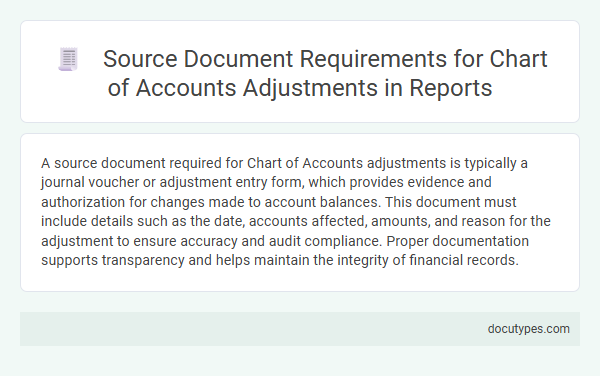A source document required for Chart of Accounts adjustments is typically a journal voucher or adjustment entry form, which provides evidence and authorization for changes made to account balances. This document must include details such as the date, accounts affected, amounts, and reason for the adjustment to ensure accuracy and audit compliance. Proper documentation supports transparency and helps maintain the integrity of financial records.
Introduction to Source Document Requirements
Source documents are essential for verifying and supporting adjustments made to the Chart of Accounts. These documents provide a clear audit trail, ensuring accuracy and compliance during financial reviews.
Introduction to source document requirements highlights the need for original, unaltered documentation such as invoices, receipts, and bank statements. These records must clearly indicate the nature and reason for the adjustment. Proper source documentation helps maintain transparency and accountability in financial reporting processes.
Importance of Accurate Source Documentation
What source document is required for chart of accounts adjustments? A detailed journal voucher or transaction receipt is essential for making accurate adjustments in the chart of accounts. Accurate source documentation ensures financial records are reliable and compliant with auditing standards.
Types of Source Documents for Chart of Accounts Adjustments
Source documents for Chart of Accounts adjustments provide the necessary evidence to support changes. These documents ensure accuracy and accountability in financial records.
- Invoices - Detail transactions that impact account balances and require adjustment.
- Bank Statements - Verify cash-related entries and corrections in accounts.
- Journal Vouchers - Serve as internal records authorizing adjustments or corrections.
Your financial adjustments rely on these documents to maintain proper audit trails and compliance.
Minimum Documentation Standards
Source documents required for Chart of Accounts adjustments must include accurate and verifiable evidence of the transaction or correction. Minimum documentation standards mandate original invoices, payment receipts, or detailed journal entries that clearly justify the adjustment. Properly maintained records ensure audit compliance and facilitate transparent financial reporting.
Documentation Submission and Approval Process
Source documents are essential for validating Chart of Accounts adjustments, ensuring accuracy and compliance with accounting standards. Proper documentation submission and approval processes maintain the integrity and traceability of financial records.
- Detailed Adjustment Request - This document outlines the specific changes required in the Chart of Accounts, including account codes and rationale.
- Supporting Financial Documents - Attachments such as invoices, journal entries, or audit reports provide evidence to justify the adjustments.
- Approval Form or Workflow Confirmation - A signed or electronically approved form confirms authorized review and authorization before adjustments proceed.
Common Errors in Source Documentation
Source documents for Chart of Accounts adjustments must accurately reflect transactional details to ensure proper accounting entries. Typical documents include invoices, receipts, and journal vouchers that validate each adjustment.
Common errors in source documentation involve missing signatures, incorrect dates, or incomplete information, leading to discrepancies in the financial records. You should carefully verify these documents to maintain accuracy and compliance during adjustments.
Verification and Validation Procedures
Source documents required for Chart of Accounts adjustments primarily include authorized adjustment forms, transaction receipts, and internal approval memos. These documents undergo rigorous verification and validation procedures to ensure accuracy, completeness, and compliance with accounting standards. Verification involves cross-referencing transaction details with supporting documents, while validation confirms the legitimacy and authorization of the adjustments before entry into the accounting system.
Regulatory and Compliance Considerations
Source documents required for Chart of Accounts adjustments must comply with regulatory standards such as GAAP, IFRS, or local financial reporting regulations. These documents provide verifiable evidence for accounting entries, ensuring transparency and accuracy in financial records.
Examples include approved journal vouchers, adjustment memos, and authorized management approvals that validate the changes made. You must retain these documents to support audits and maintain compliance with legal and internal control requirements.
Digital vs. Physical Document Management
| Aspect | Digital Document Management | Physical Document Management |
|---|---|---|
| Source Documents Required | Invoices, receipts, bank statements, and adjustment authorizations in electronic formats such as PDFs, scanned images, or digital audit trails. | Original paper invoices, printed receipts, bank statements, and signed adjustment forms stored in filing cabinets or binders. |
| Verification Process | Automated validation software cross-references data entries with digital source files to ensure accuracy of Chart of Accounts adjustments. | Manual inspections and physical cross-checking of documents against ledger entries to confirm legitimacy of adjustments. |
| Storage and Accessibility | Cloud storage solutions and enterprise content management systems provide fast retrieval and secure backup of adjustment-related documentation. | Physical document archives require organized shelving and are susceptible to damage, loss, or delays in retrieval during audits. |
| Compliance and Audit Trails | Digital timestamps and secure audit logs create tamper-evident trails, aligning with regulatory standards for financial reporting and internal controls. | Physical signatures and manual logs offer evidence but are more prone to human error and require extensive effort during compliance reviews. |
| Efficiency and Cost | Reduces paper usage and administrative overhead, lowering costs related to storage space and document handling time. | Higher expenses related to physical storage, maintenance of filing systems, and time-intensive manual processes. |
| Recommendations | You should consider implementing digital source document management for Chart of Accounts adjustments to streamline verification and enhance document security. | Retain critical physical documents as backups but prioritize transitioning to digital formats to improve accuracy and compliance. |
What Source Document Is Required for Chart of Accounts Adjustments? Infographic

